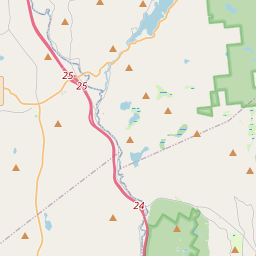Church of the Good Shepherd
Historical marker location:
Chestertown, New York
( Marker is on Main Street (U.S. 9) south of Riverside Drive/Theriot Avenue, on the right when traveling south.)







© OpenStreetMap contributors
Loading...
Searching for other points of interest within 3 miles of this location.In the mid-19th century, New York City was the largest slaveholding city in the United States, and the largest slave market was located on Wall Street.
About Warren County
Warren County Timeline
Warren County, located in upstate New York, has a rich and diverse history that spans several centuries. The region was originally inhabited by the Algonquin and Iroquois Native American tribes before European settlers arrived in the 18th century. Originally part of Albany County, Warren County was established in 1813, named after American Revolutionary War hero General Joseph Warren.
In the early years of settlement, agriculture played a significant role in Warren County's economy. Farmers cultivated crops such as corn, wheat, and potatoes, while the region's abundant forests provided timber for construction and trade. The completion of the Champlain Canal in 1823 opened up new opportunities for commerce and transportation, linking Warren County to markets throughout the Hudson River Valley.
The mid-19th century brought significant changes to the county with the emergence of the lumber and mining industries. The vast forests of Warren County were harvested for timber, which was used for building homes, ships, and railroad ties. Additionally, iron mines were opened, and the county became an important producer of iron ore. This period of growth and industrialization led to an increase in population and the development of new towns and villages throughout Warren County.
With the decline of the lumber and mining industries in the late 19th century, tourism emerged as a major economic driver for Warren County. The region's natural beauty, including Lake George, the Adirondack Mountains, and numerous recreational opportunities, attracted visitors from near and far. Today, Warren County continues to thrive as a popular tourist destination, offering a wide range of outdoor activities, cultural attractions, and historical sites that showcase the county's fascinating past.
In the early years of settlement, agriculture played a significant role in Warren County's economy. Farmers cultivated crops such as corn, wheat, and potatoes, while the region's abundant forests provided timber for construction and trade. The completion of the Champlain Canal in 1823 opened up new opportunities for commerce and transportation, linking Warren County to markets throughout the Hudson River Valley.
The mid-19th century brought significant changes to the county with the emergence of the lumber and mining industries. The vast forests of Warren County were harvested for timber, which was used for building homes, ships, and railroad ties. Additionally, iron mines were opened, and the county became an important producer of iron ore. This period of growth and industrialization led to an increase in population and the development of new towns and villages throughout Warren County.
With the decline of the lumber and mining industries in the late 19th century, tourism emerged as a major economic driver for Warren County. The region's natural beauty, including Lake George, the Adirondack Mountains, and numerous recreational opportunities, attracted visitors from near and far. Today, Warren County continues to thrive as a popular tourist destination, offering a wide range of outdoor activities, cultural attractions, and historical sites that showcase the county's fascinating past.
Warren County Timeline
This timeline provides a condensed summary of the historical journey of Warren County, New York.
- 1768 - Warren County founded as part of Albany County in the Province of New York.
- 1772 - The town of Queensbury is settled.
- 1780 - During the American Revolutionary War, General John Stark's forces win the Battle of Bennington, which helps to secure the area.
- 1813 - Warren County is officially formed on March 12th, 1813.
- 1839 - Lake George steamboats begin operating, promoting tourism in the region.
- 1851 - A fire destroys a significant portion of the county seat, resulting in the relocation of the county government to Glens Falls.
- 1863 - The Battle of Fort Ann, a minor engagement during the American Civil War, takes place in Warren County.
- 1908 - The Glen Iris Inn on Lake Placid, now known as The Sagamore, opens and becomes a renowned resort attracting wealthy visitors.
- 1928 - The Sacandaga Reservoir is completed, flooding large portions of the county and displacing numerous communities.
- 1950s - The construction of the Northway (Interstate 87) brings increased accessibility to Warren County and boosts tourism.